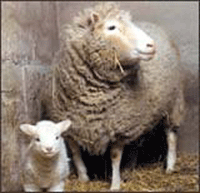Cloning
| Ancient
German folklore includes, among other bizarre creatures, doppelgangers,
evil spirits who take on the appearance of a person and then plague the
lives of that person and his/her family...probably the influence for such
pop culture ideas like the 1956 film, The
Invasion of the Body Snatchers, in which an
alien race came to Earth to clone humans individually in giant peapods;
once hatched, the pod-people would kill their human counterpart...Where am
I going with this? The idea of replicating life is not new. |
|

Dolly, the first cloned sheep
|
|
Recently,
geneticists have made great progress in their unraveling of the human web.
Earlier advances in tissue regeneration, growth, and cloning spurred scientists to finally achieve success with Dolly,
the first major clone "birthed" in a Scottish lab in 1997 . Why
stop there...especially with years of science fiction promises and the
desire to bring grandma back? |
|
The
issue of human cloning raises great controversy. Should scientists tamper
with the demystification of human life by creating it generically? Could
cloning run amok if the ability fell into the hands of mad scientists bent
on producing an army of Hitlers -- would those clones really be Hitlers,
or just a bunch of individuals with really bad moustaches? Would the
clones even be people? Would they have souls? Is exploring human genetics
in this manner playing God? If we aren't meant to experiment in this
manner, then why are we able to -- why are we curious? What kind of ethics should the geneticists consider and adhere to? Is the beginning of cloning
the end of the individual? Can you answer these questions (please go to Nicenet to begin/continue class debate)? |
Huxley
Makes Babies...a
lot of them
| As we've
learned from the first three chapters, Huxley's dystopic vision has
removed human reproduction, replacing it with the mass production of
humans in laboratory-factories -- combining biology and Ford's work.
Once human ova is fertilized, it is separated into five social
castes (Alpha, Beta, Delta, Gamma, and Epsilon), in order of social
standing. Alphas and Betas are grown to be the "leaders"
or upper class of society, while the bottom three castes are then
further separated and bokanovskified -- multiplied into hundreds of
cloned embryos that are further manipulated by embryonic alcohol
injection and radiation poisoning to grow, physically and
mentally stunted, into a stratified working class. |
|
Return
to main page.
Return to Technological Advancement page. |